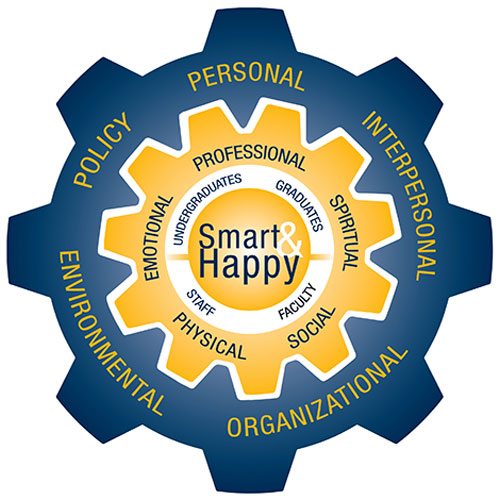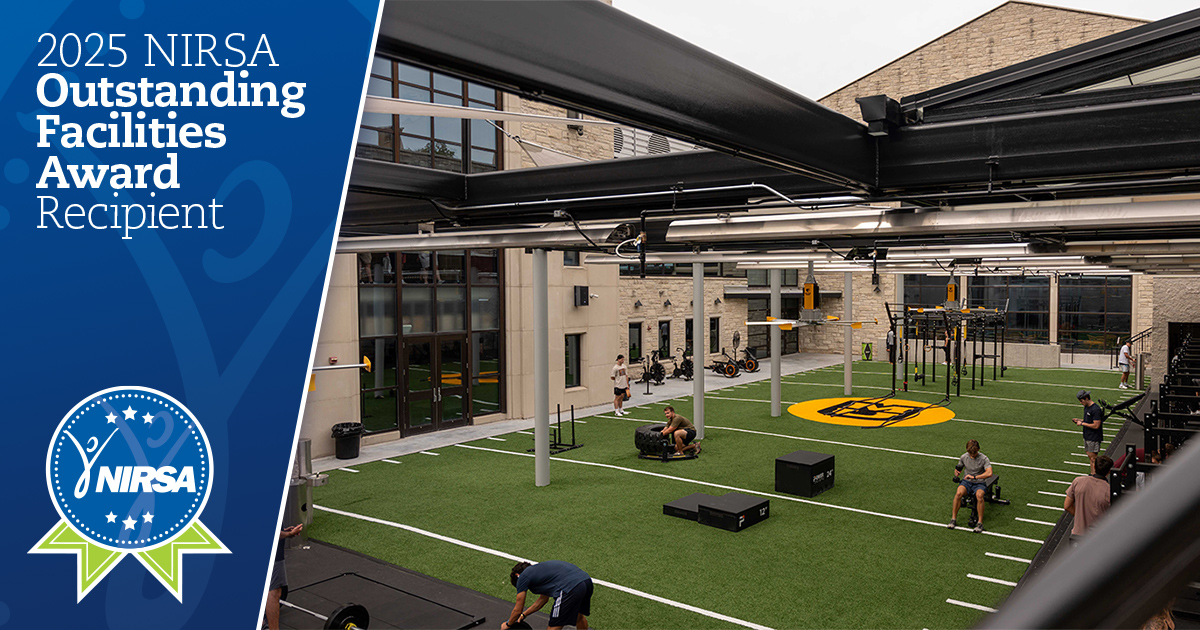The need to create a culture of integrated wellness is emerging on college campuses as both a new concept and a re-imagining of traditional recreation offerings. Leading facilities often encompass preventive as well as reactive services including student health, counseling centers, and programming designed to appeal to historically-underserved populations.
The trend extends beyond facility design and usage. It marks a positive, health-conscious change in university reporting structures and goals. Campus recreation is being tasked by universities to implement this new concept of wellness on college campuses. Through recreation departments and personnel, many schools are embracing innovation regarding wellness. The Georgia Institute of Technology is one of the schools at the forefront of this emerging trend in collegiate recreation.
Georgia Tech is strengthening its commitment to wellness on campus by re-envisioning the scope, breadth, and model of its community health and wellbeing programs and services. In 2015, the school committed to focusing more resources on an integrated wellness and wellbeing approach by creating the new Georgia Tech Health & Well-Being office.
Georgia Tech Health & Well-Being brings crucial components of university health and wellbeing—including the Campus Recreation Complex (CRC), the Office of Health Promotion, and Stamps Health Services—under one umbrella. This model allows each component to interweave a collaborative culture of health and wellbeing into every aspect of what they do. The Campus Recreation Complex is an integral pillar in Georgia Tech’s objective of providing holistic wellbeing programing and services to a continually-expanding audience.
The move to a new model
The move to a more-integrated health and wellbeing approach did not happen overnight; it was instead a lengthy and thoughtful process involving cooperation and innovation from many different aspects of the Georgia Tech community as well as leadership from the Campus Recreation Complex. Historically, the CRC reported to the Division of Student Affairs, which is now called Student Life. While the CRC collaborated on many programs and events across campus, its main focus was geared towards students and the student learning outcomes of those who walked through its main doors every day.
A shift in this mindset began in 2008 when the CRC and Health Promotions formed a coalition aptly referred to as Go T.E.C.H. or Teams Encouraging Campus Health. Go T.E.C.H was charged with creating community-wide programs that encouraged health and physical activity and leveraged collaboration and innovation to promote their mission—even creating a team challenge between student groups and departments to encourage participation. A strategic plan focused on the overall health and wellbeing of the Georgia Tech community emerged from this challenge.
After receiving top-down review from University President Dr. G.P. “Bud” Peterson, the strategic plan was presented to the Mental Health Task Force and the Sexual Violence Task Force. These task forces created a detailed analysis of existing university programs and services and formed recommendations for how these programs and services—or new and different programs and services—could serve the Georgia Tech community more comprehensively.
In 2015, the Center for Community Health and Wellbeing was finally created after the approved realignment of the CRC, Health Promotions, and Stamps Health Services into one comprehensive model. Dr. Suzy Harrington, the Center’s first and current Executive Director, was hired in December 2015 and immediately began encouraging the type of collaborative work that had led to the initial creation of the Center, which has since been rebranded to be Georgia Tech Health & Well-Being.
Dr. Harrington has evolved the Go T.E.C.H. coalition into a formal Well-Being Council and invited campus partners to a health and well-being retreat to discuss current initiatives and identify gaps, and to discover broader opportunities for collaboration. In addition, a five-dimensional model was created and Go T.E.C.H. was rebranded as Tech Empowers Community Health to better reflect the work of Health & Well-Being. Georgia Tech is well on its way to realizing the positive outcomes of this new model.
Broadening the scope of wellness and community
This collaborative, integrated wellness approach creates an umbrella under which a larger community can be served and receive more programs and services centered on the whole picture of wellness. A key element of Georgia Tech’s health and wellbeing strategy is to focus more on the community as a whole. While the same programs and services will continue to be offered to students, the university has broadened its services to cater to faculty, staff, and alumni through a variety of specific initiatives.
Combining the efforts of the CRC, Health Promotion, and Health Services allows Health & Well-Being to reach a broader audience in a multitude of ways, including better cross-marketing initiatives, a unified voice on well-being content, and more exposure to students and employees who might not generally use the CRC.
Georgia Tech Health & Well-Being also increases awareness of the dimensions of wellness that go beyond typical physical health. Their emphasizes the equal importance of the social, emotional, spiritual, and professional aspects of health. Focus on this many-dimension model provides ample opportunity for Georgia Tech to strengthen current programs and offerings so that patrons better understand and develop their total wellbeing.
In addition to focusing on programs and services, Georgia Tech Health & Well-Being uses a multi-level approach to behavior change that incorporates personal, interpersonal, organizational, and environmental policy. This multi-dimensional approach “helps develop a community that is smart and happy and healthy,” says Caroline Dotts, Associate Director, Healthy Lifestyle Programs.
Sharing a mission and vision for student success
The many actors contributing to the success of Georgia Tech Health & Well-Being are deeply committed to a shared mission and vision of student success. This has eased the move to Georgia Tech’s strategy model. Both top-down and bottom-up support have been crucial to their success. From its conception, Georgia Tech Health & Well-Being received top-down support; President Peterson envisioned an integration of health and wellbeing partners for the campus community. From below, Georgia Tech students, faculty, and staff—especially those involved in the Go T.E.C.H. coalition—were supportive of increased health and wellbeing programs and services as well as increased coordination amongst different program areas. Continuing the momentum of this community support model, new programs will include wellbeing advocates to better strengthen and infuse a bottom-up approach.
Georgia Tech Health & Well-Being is also well positioned in the university to effectively create positive engagement in areas outside its umbrella. Reporting to Campus Services, they are able to focus on aligning health and wellbeing resources for the entire Georgia Tech community, including employees and students. “The initiative is an effort to explore alignment opportunities for wellness, mental health, alcohol and drug education, and sexual violence prevention. We are taking a concerted institute-wide approach to creating a safer and healthier campus, one focused on the overall health and wellbeing of our entire campus community,” notes President Peterson.
Realizing this model, the CRC also works closely with Student Life, especially Counseling Services, Dining, and other partners across campus like Sustainability and the Arts Department. “Cross-collaboration pools resources and enables campus partners to join forces, which creates opportunities to reach more members of the Georgia Tech community,” says Dr. Harrington.
As one of three integral pillars, the CRC actively collaborates with the departments of Health Promotion and Stamps Health Services. Common alignment of the mission and vision of each pillar is crucial. Georgia Tech Health & Well-Being’s mission is to promote, nurture, and enrich a culture of health, wellbeing, and caring so that Georgia Tech students and employees will flourish and be fulfilled individually within the community where they live, learn, work, and play. Similar to that of the larger office, the CRC’s mission is to create a safer and healthier campus focused on the overall health and wellbeing of the entire campus community.
Overcoming obstacles to change
While collaboration is crucial to Georgia Tech Health & Well-Being’s success, its team also recognizes the need for incremental change and slowly nudging this health and wellbeing cultural shift together. “Most individuals think they know what health and well-being is—they often think of diet and exercise. Health and wellbeing is who we are—not what we do,” says Caroline Dotts. This misperception is being tackled by Georgia Tech Health & Well-Being‘s efforts to work to reframe the definition of health and wellbeing.
“It is a harmony, not a balance, of our wellbeing. It is about being the best we can be each moment, striving for excellence, not perfection. This shift isn’t easy,” says Dr. Harrington. While this change is a challenge, Georgia Tech Health & Well-Being as a whole is facing this hurdle as an opportunity to better position itself as a leader amongst wellness services and programs.
Fostering new and innovative approaches to create a culture of health
“We are creating a culture of health and wellbeing on campus where students, faculty, staff, and alumni can flourish and be fulfilled; where they can be smart and happy; where they can be less stressed; where they can thrive,” says Dr. Harrington. In order to continually improve this culture of health and wellbeing, Georgia Tech Health & Well-Being constantly measures the success of its programs and monitors its health and wellness policy. It is always innovating and considering new ways to integrate health and wellbeing into living/learning communities.
Georgia Tech Health & Well-Being is also diving into more research on how this integrated approach affects students’ GPAs, retention rates, and even creates more opportunity for students to succeed. Because it is always striving to improve, the CRC looks forward to implementing surveys on participation. These surveys will allow research into the correlations between program and service usage and indicators of success including GPA, retention, and resiliency.
Georgia Tech Health & Well-Being’s collaborative efforts allow the team at the CRC to constantly reflect on the state of the community and focus on questions that matter, such as ‘Are we less stressed?’ ‘Are we flourishing and feeling fulfilled?’ ‘Are we thriving in one or all areas of our wellbeing dimensions?’” says Caroline.
Georgia Tech has truly embraced integrated wellness
Georgia Tech Health & Well-Being has created a model that takes programs and services to a new level of integration. While this approach relies on the cooperation of each pillar, the cross-dimensional model also allows each pillar to thrive. As more and more campuses shift toward integrated models, campus recreation can and will play a larger role. Integrated wellbeing is all about creating ever more exciting opportunities for campus recreation professionals to engage with student and community learning outcomes.
During this shift toward integrated wellbeing, it is crucial to remember that no one department “owns” wellness or wellbeing. Everyone on campus—be it student or employee or community member—should have the opportunity to learn more about and focus on their own health and wellbeing over the course of their lifetime. Even as campus recreation integrates into different models of integrated wellness services, it can be a leader in implementing crucial education and creating access for all to engage in an active, healthy, and well lifestyle.
Learn more
This member spotlight is part of an extended series exploring the emerging trend of integrated wellness in campus recreation. NIRSA’s emerging trends in collegiate recreation project is supported by Precor.
For more information about Health & Well-Being at Georgia Tech, please contact Suzy Harrington, Executive Director. If you have questions about NIRSA’s Emerging Trends in Campus Recreation project, please contact NIRSA Research Coordinator Ruben Guzman.
The conversation about creating a culture of health and wellbeing will continue at the 2017 NIRSA Annual Conference. Registration will open in early November for the 2017 NIRSA Annual Conference & Campus Rec and Wellness Expo, February 21-24, in National Harbor, Maryland.
Photos courtesy of the Georgia Institute of Technology
- If you are interested in highlighting your campus or a NIRSA member’s achievements on your campus, pitch us your ideas.
Alice Kersting is currently the Special Projects Coordinator at NIRSA. She can be reached at ajkersting@gmail.com.









